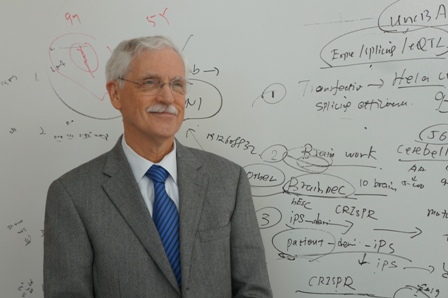Dr. Brown collaboration with Wave Life Sciences develops promising therapy
 In December 2017, ALS News Today featured a collaborative initiative that Dr. Brown has developed with Wave Life Sciences, an innovative biotech company based in Cambridge, Mass. Together, they are working on a therapeutic approach that has proven to reduce levels of ALS markers in animal studies.
In December 2017, ALS News Today featured a collaborative initiative that Dr. Brown has developed with Wave Life Sciences, an innovative biotech company based in Cambridge, Mass. Together, they are working on a therapeutic approach that has proven to reduce levels of ALS markers in animal studies.
The potential therapy, called WVE-3972-01, has so far been shown to reduce markers of the most common form of inherited ALS and frontotemporal dementia (FTD), which stems from a mutation in a gene called C9orf72 (C9). While scientists still do not know exactly how this genetic mutation leads to ALS, one hypothesis is that the faulty gene generates a set of abnormal, toxic proteins, known as dipeptides. Another possibility is that the gene mutation causes messenger RNA* to clump, preventing it from producing normal C9 protein.
The treatment aims to silence the C9 gene by binding to the faulty messenger RNA arising from C9 mutations. This promotes the degradation of the RNA, stops the production of toxic dipeptides and reduces the RNA clumping. Hopefully this will slow or even reverse the course of ALS. Wave plans to start clinical trials of WVE-3972-01 as a treatment for ALS and FTD in the last quarter of 2018. Researchers hope this will prevent messenger RNA clumping and reduce levels of the mutant, adverse C9 proteins.
Wave’s treatment is based on technology that was discovered and developed at the Worcester Foundation for Biomedical Research, which is now part of UMass Chan Medical School, and Mass General Hospital.
The WVE-3972-01 therapy reduced C9 messenger RNA levels by 70 percent in animal models. This led to a 76 percent reduction in faulty proteins in the spinal cord and an 87 percent reduction in the outer layers of the brain. The reduction lasted eight weeks, researchers said.
Dr. Brown states that “the degree of silencing of C9 by WVE-3972-01 and the beneficial effects in animal studies are quite compelling. We are very excited at the prospect of seeing this unique therapy in clinical trials in C9 patients in the near term.”
The therapy’s potency and sustained effect on the animals “make us optimistic regarding the potential of WVE-3972-01,” said Dr. Michael Panzara, head of Wave Life Sciences’ neurology program. “The reduction of mutant C9orf72 proteins with preservation of healthy C9orf72 proteins is likewise encouraging,” he said.
*DNA contains instructions that are used to produce proteins, which serve as the basis of our bodies structures. The mechanism that carries those instructions from the DNA to the areas in our cells that produce those proteins is called messenger RNA.


